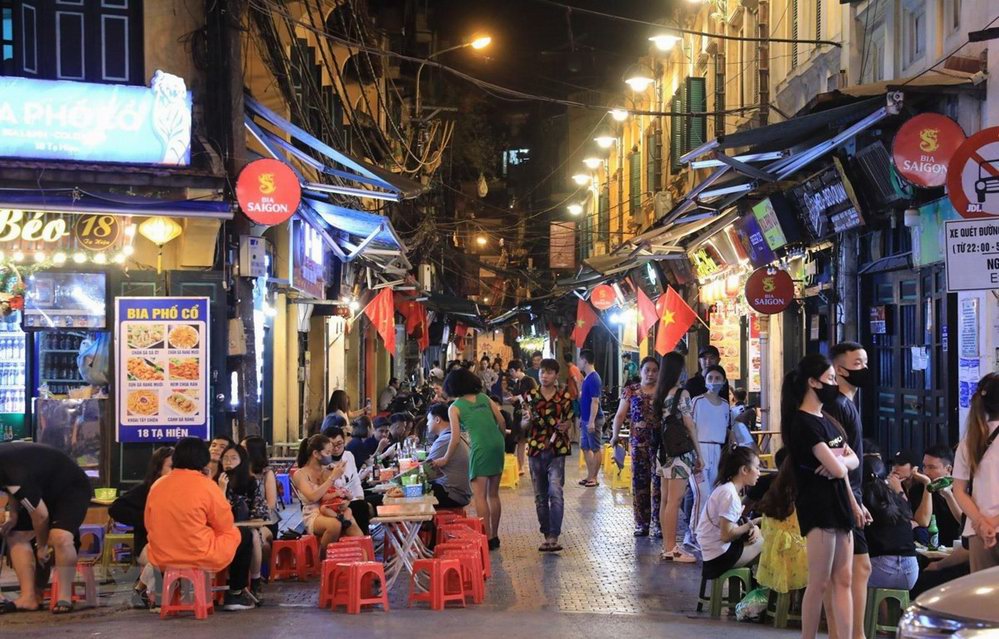
 Vietnam package tours
Vietnam package tours
 Hanoi tours
Hanoi tours
 Halong tours
Halong tours
 Halong cruises
Halong cruises
 Sapa tours
Sapa tours
 Ninh Binh tours
Ninh Binh tours
 Saigon tours
Saigon tours
 Mekong tours
Mekong tours
 Mekong cruises
Mekong cruises
 |
||
|
VIETNAM TRAVEL MAP
|
||
 |
 |
 |
||
 |
 |
Hanoi backpackers streets - the east-west symphony in Hanoi
The backpacker area in the Old quarter
has become a vivid symbol of modern Hanoi. This place is not only an
attractive destination for international tourists, but also a space for
Vietnamese people to explore, create, start businesses and trade. In the
constant flow of integration, backpacker streets are a clear demonstration
of the adaptability and creativity of Vietnamese people.

Cultural exchange in daily life
The International neighborhoods in Hanoi are always interesting cultural
intersections in daily life, where the East and West colors naturally
intertwine. Just one afternoon walking around these neighborhoods, it is not
difficult to encounter a unique cultural mix: a traditional corn cake stall
next to a colorful Indian restaurant, a Vietnamese milk tea shop next to a
French-style beverage shop, or a stilt house cafe by West Lake - where
foreigners and locals enjoy tea, watch the sunset and share stories.
A long-time resident of Ta Hien Street commented: “This area is more
vibrant, which has both positive and negative aspects, but clearly the
multicultural atmosphere has brought new vitality to the whole street.”
“There is no specific moment that marks my connection to Vietnam,” said
Adrian Bernard Hickey, an Australian citizen who has lived in Hanoi for more
than 10 years. “It was a quiet but profound process. I found similarities
between Vietnamese and Australians in their sense of humour, their love of
life, their hearty laughter and the way they enjoy life. That made me feel
not like an “outsider” but part of the community.”
This cultural exchange space brings bold experiences and directly stimulates
a new economic life for the “International” street. It is the spirit of
cultural openness that makes Hickey not hesitate to introduce friends to
invest and open shops around this area. It is also the springboard for
creative business models such as homestay boutique, fusion cafe or art
studio to flourish, turning the “Western” street into a vibrant startup
destination, where culture and economy blend.
With the increasing number of international tourists, service industries
such as restaurants, hotels, bars and souvenir shops in this area are always
bustling. Small businesses, from sidewalk eateries to fashion stores,
benefit from the influx of tourists to Hanoi, creating thousands of jobs for
local people.
Hieu, Founder of the cocktail bar “Twins Cocktail and Wine” in Ngo Huyen,
believes that the “international” street is an ideal space for startup
ideas. He said: “This area attracts a lot of tourists and Vietnamese
customers, so I think this is a very suitable place to do business and test
new products and services.”
Many young people have also taken advantage of the “international” streets
to open cafes with unique styles such as book cafes, pet cafes or art
spaces. These models not only attract tourists but also create a creative
community where young entrepreneurs can learn and share experiences.
Hickey has also contributed a small part to Vietnam's integration journey.
During more than a decade working at large corporations such as Golden Gate
and Sun Group in the food and service sector, he has helped many young
Vietnamese people approach and learn about Western service culture,
professional working style and creative thinking. He said: "I see young
Vietnamese people growing up every day - not only learning new ways of
working, but also learning how to think innovatively. That makes me happy
and I believe that I have contributed to a Vietnam that is changing
strongly."
However, economic development in the “international” area also poses
challenges. The concentration of too many tourists can put pressure on
infrastructure, the environment and increase the cost of living in this
area. Therefore, managers need to have sustainable development strategies,
ensuring that the international area is both an economic driving area and a
harmonious, friendly space for local people and international tourists.
From a street corner to a global vision
The formation of such neighborhoods helps cities, especially Hanoi - a place
with a deep history and cultural heritage - become dynamic and modern while
still maintaining its own identity. This is the foundation for attracting
investment, developing high-quality tourism, and at the same time creating
an economic ecosystem, helping to improve the global competitiveness of
Vietnamese cities.
However, besides the positive aspects, strong integration also raises the
question: "Will accepting too many cultures cause the national identity to
fade away?" This is not an unreasonable concern, when many neighborhoods are
gradually becoming unfamiliar to local people due to excessive "foreignization".
The problem is to know how to filter and localize new elements, turning
diversity into a catalyst for creativity, not fading the core of Vietnamese
culture. Hieu said: "I don't think it has been Westernized. When I talked to
many Western customers who came to the restaurant for the first time, they
still told me that Vietnam still has something special, Hanoi still has
something very "cultural"."
From a small street corner, where the sound of multilingual street music
echoes, the smell of coffee wafts in the air and blends with the taste of
hot Pho, we can see the image of a Vietnam gradually stepping out into the
world : not noisy, not ostentatious, but full of courage and creativity.
Such neighborhoods, if properly oriented, are a mirror reflecting the
journey of integration with identity, where Vietnam not only integrates but
also shines.
As a professional tour operator, BudgetVietnamTours.com offers
cheap tours in Vietnam with
flexibility in scheduling, destinations, and activities, ensuring authentic
experiences like visiting local villages or dining at non-touristy
restaurants.




